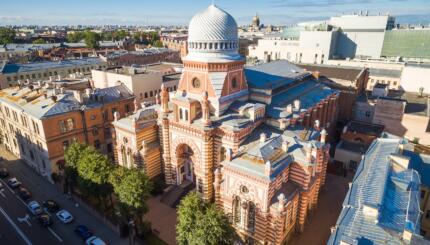The process of emancipation and modernization came later and more slowly for Jews in the east than to their co-religionists in the west. Eastern Jewish communities faced a significant stumbling block to any change, namely the absolutist governments that ruled them. Still, modern ideas trickled in. Books, pamphlets, and students of the Haskalah (the Jewish enlightenment movement) traveled east. Meanwhile, industrialization and urbanization created a new socioeconomic order in which Jews figured as both capitalists and workers. Jewish reactions to modernization can be further explored in other articles on this site, including pieces on socialism and emigration. The following article examines the connections among the processes of modernization, enlightenment, and emancipation in Eastern Europe. It is reprinted with permission from A Historical Atlas of the Jewish People edited by Eli Barnavi and published by Schocken Books.
In the second half of the eighteenth century, western winds brought changes to Eastern Europe. For the Jews of "Poland"–Lithuania, Volhynia, Galicia–the agent transmitting foreign influences was the government itself. The "enlightened despots" who had inherited hundreds of thousands of Jews with the partition of Poland, wanted to "reform" their new subjects according to the fashionable ideas of the French philosophes.
The officials of the absolutist "enlightened" state were naturally ill disposed toward the autonomy of the Jews, and their desire was to turnthem all into loyal and "useful" subjects. "Useful" in the sense of the Physiocrats meant having productive occupations: agriculture and crafts. The method adopted was that of "the carrot and the stick": those who showed themselves willing to change were encouraged, while the others were bullied to enter, step by step, into a modernized mold. In this process of enforced acculturation, the Jewish state schools (established in Galicia during the late eighteenth century and in Russia during the 1840s) played a major role in the forming of westernized elites.
This authoritarian policy was pursued in Eastern Europe until mid‑nineteenth century. The Russian and Austrian authorities invested considerable effort in modernizing the Jews, but they encountered resistance among the Jewish masses and attained negligible concrete results. Westernizing influences affected only small and isolated circles of maskilim (those who adopted the ideas and values of the Haskalah, the Jewish version of the Enlightenment) and some wealthy merchants in the larger cities. Moreover, these effects were due to direct contacts with the German Haskalah rather than to the reforming zeal of the authorities.

Help us keep Jewish knowledge accessible to millions of people around the world.
Your donation to My Jewish Learning fuels endless journeys of Jewish discovery. With your help, My Jewish Learning can continue to provide nonstop opportunities for learning, connection and growth.
The Haskalah was indeed an all‑Ashkenazi phenomenon. Jews from Eastern Europe played an important part in the emergence of the movement in Berlin. A second Haskalah center developed in Koenigsberg in eastern Prussia near the Lithuanian border. Members of the eastern communities participated in Moses Mendelssohn’s enterprise of religious and intellectual revival (for example, the translation of the Bible into German accompanied by a rationalist commentary in Hebrew). Maskilim who had lived for a time in Germany returned to Poland and disseminated the ideals of the movement. Meanwhile, in the large cities–Warsaw, Cracow, St. Petersburg–the Jewish economic elite adopted the cultural values of its social milieu. The entire phenomenon–secular studies, loyalty to the modern centralized state, integration into society, and cultivation of Hebrew–was, however, very limited in scope, and in the second or third generation the emphasis on assimilation often led to conversion to Christianity.
It was only in the second half of the nineteenth century that society in Eastern Europe was truly transformed. This metamorphosis, however, occurred not due to government coercion, but as a result of overall modernizing processes. Within a few decades, the economic and social upheavals liquidated the traditional way of life and caused the displacement of hundreds of thousands of Jews.
Alexander II’s accession opened an era of reform in Russia. Serfdom was abolished and the empire was opened to capitalist enterprise. The former seigniorial system which had incorporated the Jews for centuries was crumbling, and the Jewish townlet (the shtetl) was thus cut off from its economic roots. At both ends of the social ladder, as both proletarians and as capitalists, the Jews gradually entered the new socioeconomic system. The political liberalization introduced by Alexander II’s reforms was a catalyst for the emergence of a prosperous Jewish bourgeoisie, and a new Jewish intelligentsia was graduating from Russian high schools and universities. In the 1850s and 1860s, Jewish periodicals in Hebrew, Russian, and Polish began to appear in St. Petersburg, Odessa, Kiev, Warsaw, and Lvov, weaving a network of communication cross eastern Europe.
Modernization, obviously, is never a painless process. The westernization of Russo-Polish Jewry was no exception. Two major developments reflected the difficulties: first, the rise of radical ideologies; second, mass migration, both internal (from Lithuania to southern Russia and western Poland) and external, towards the West.


